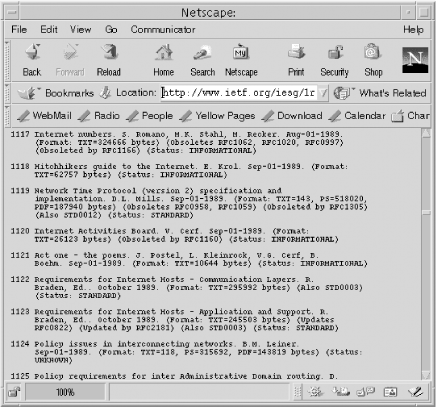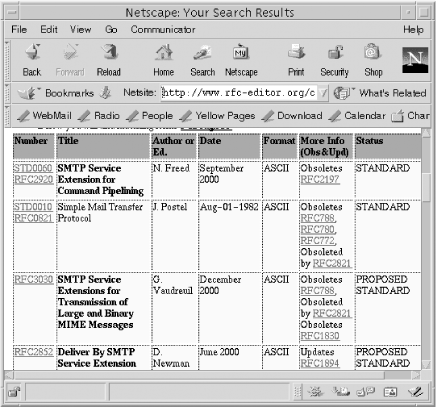Section G.4. Retrieving RFCs
G.4 Retrieving RFCsThroughout this book, we have referred to many RFCs. These are the Internet documents used for everything from general information to the definitions of the TCP/IP protocol standards. As a network administrator, there are several important RFCs that you'll want to read. This section describes how you can obtain them. RFCs are available at http://www.ietf.org. Follow the RFC Pages link from that home page. The page that appears allows you to retrieve an RFC by specifying its number. The page also has links to the RFC Index and the RFC Editor Web Pages. The index is useful for general browsing. It helps you map RFC names to numbers, and it tells you when an RFC has been updated or replaced. Figure G-1 shows a network administrator scrolling through the index looking for RFC 1122. Figure G-1. The RFC index Of even more interest are the RFC Editor Web Pages. Selecting this link takes you to http://www.rfc-editor.org, where you can select RFC Search and Retrieval. The page that is displayed provides access to a hyperlinked RFC index and to a search tool that allows you to look for RFC titles, numbers, authors, or keywords. Assume you want to find out more about the SMTP service extensions that have been proposed for Extended SMTP. Figure G-2 shows the first page displayed as a result of this query. Figure G-2. An RFC web search The Web provides the most popular and best method for browsing through RFCs. However, if you know what you want, anonymous FTP can be a faster way to retrieve a specific document. RFCs are stored at ftp://ftp.ietf.org in the rfc directory. This stores the RFCs with filenames in the form rfcnnnn.txt or rfcnnnn.ps, where nnnn is the RFC number and txt or ps indicates whether the RFC is ASCII text or PostScript. To retrieve RFC 1122, FTP to ftp://ftp.ietf.org and enter get rfc/rfc1122.txt at the ftp> prompt. This is generally a very quick way to get an RFC if you know what you want. G.4.1 Retrieving RFCs by MailWhile anonymous FTP is the fastest way and the Web is the best way to get an RFC, they are not the only ways. You can also obtain RFCs through electronic mail. Electronic mail is available to many users who are denied direct access to Internet services because they are on a nonconnected network or are sitting behind a restrictive firewall. Also, there are times when email provides sufficient service because you don't need the document quickly. Retrieve RFCs through email by sending mail to mailserv@ietf.org. Leave the Subject: line blank. Request the RFC in the body of the email text, preceding the pathname of the RFC with the keyword FILE. In this example, we request RFC 1258. % mail mailserv@ietf.org Subject: FILE /rfc/rfc1258.txt ^D The technique works very well. In the time it took to type these paragraphs, the requested RFC was already in my mailbox. |
EAN: 2147483647
Pages: 181